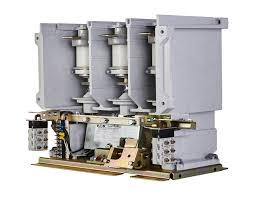Vacuum Contactor Market Outlook: Retrofit, Renewables, and Smart Switchgear

Introduction
Vacuum contactors are an essential class of medium-voltage switching devices used to make and break electrical circuits safely and reliably. Unlike air or oil breakers, vacuum contactors extinguish the arc formed during interruption inside a sealed vacuum bottle, giving them long service life, low maintenance, and superior dielectric recovery. Typical applications include motor starting, capacitor switching, medium-voltage motor control centers, auxiliary circuits on power plants and renewables, and industrial drives. As electrification, automation, and the electrified industrial base expand globally, the demand for robust, efficient, and compact vacuum contactors is rising across power generation, manufacturing, infrastructure, and transportation sectors.
Market dynamics (Drivers, Challenges, Opportunities)
Drivers: Energy efficiency initiatives, stricter safety and reliability standards, and the global push to modernize aging electrical infrastructure are key growth drivers. Vacuum contactors enable compact, modular switchgear designs and reduce lifecycle maintenance compared with oil-filled or air-blast alternatives, which appeals to asset owners aiming to lower operating expenditures. The electrification of transport (rail and e-mobility depots), growth in data centers, and expansion of distributed generation (solar farms, battery storage) require dependable medium-voltage switching for protection and control—another demand vector. Additionally, rising automation in manufacturing and increased adoption of soft-starters and VFDs create more use cases for vacuum contactors in motor control.
Challenges: Price pressure from low-cost manufacturers, particularly in some regional markets, and the presence of alternative switching technologies (e.g., SF₆ gas-insulated switchgear and advanced solid-state switches) can constrain market expansion. Capital expenditure cycles in heavy industries and utilities are influenced by commodity prices, slowing procurement during downturns. Technical challenges include ensuring reliable performance under severe environmental conditions (high humidity, salt spray, vibration) and maintaining supply of high-quality vacuum interrupter components—a specialized manufacturing area. Regulatory variations across regions (e.g., different testing/acceptance standards) also complicate global product roll-out.
Opportunities: Two major opportunities stand out. First, retrofit projects replacing obsolete oil or air MV contactors with vacuum technology offer a large addressable market, especially in regions with aging grids. Second, the transition to cleaner energy and battery-backed microgrids opens new frontend markets where vacuum contactors provide safe islanding and switching for medium-voltage battery energy storage systems (BESS) and renewable farms. Advances in digital condition monitoring and IoT connectivity for switchgear present a value-add: vendors bundling vacuum contactors with sensors and analytics for predictive maintenance can capture premium positions. Niche opportunities also exist in rail electrification, shipboard power systems, and hazardous location motor control.
Market segmentation
By Current Rating: Low/medium (up to 630 A), medium/high (631–1600 A), high (>1600 A). Lower ratings serve general motor control, while higher ratings address heavy industrial and utility needs.
By Voltage Class: up to 7.2 kV, 7.2–15 kV, and above 15 kV—each segment tailored to distribution or specialized industrial networks.
By Contact Type: Standard motor duty contactors, capacitor switching contactors, and custom engineered switching assemblies. Capacitor switching contactors are specially designed to handle inrush and prevent overvoltage transients.
By End-User Industry: Power generation & utilities, oil & gas, mining & metals, manufacturing, rail & transportation, data centers, renewable energy & storage, marine & offshore.
By Product Form: Standalone vacuum contactors, integrated motor control centers (MCCs) with vacuum contactors, vacuum contactor modules in cubicle switchgear.
Regional analysis
Asia-Pacific currently represents the largest volume market due to aggressive industrialization, rapid expansion of power and rail infrastructure, and a vast retrofit opportunity set in China, India, and Southeast Asia. Local manufacturers are increasingly competitive, enabling wide penetration. Europe favors high-reliability vacuum contactors in data centers, rail systems, and renewables, driven by strict safety and environmental standards. North America sees steady demand from utilities modernizing distribution substations and from large industrial consumers upgrading motor control centers. Middle East & Africa present growth in oil & gas, petrochemicals, and new power plants, though procurement is often project-timed. Latin America shows selective growth, particularly in mining and transport electrification projects.
Key trends
- Retrofit wave: Utilities and industrial plants replacing oil/air contactors with vacuum solutions to reduce maintenance and environmental risk.
- Integration with smart switchgear: Vacuum contactors paired with sensors (vibration, contact wear, temperature), enabling predictive maintenance and remote diagnostics.
- Capacitor switching specialization: Growing demand for contactors designed to switch capacitive loads without causing harmonics or transient overvoltages.
- Compact modular architectures: Preference for modular MV MCCs and containerized substations where vacuum contactors deliver high reliability in smaller footprints.
- Rail and marine adoption: Electrification of rail networks and stricter marine emission rules drive need for robust medium-voltage switching onboard and at depots.
- Supply chain localization: Regional manufacturers increasing local production of vacuum interrupters to reduce lead times and exposure to global supply shocks.
Future outlook
The vacuum contactor market is projected to grow steadily over the next decade, supported by infrastructure modernization, renewable integration, and industry electrification. Growth will be strongest in retrofit and retrofit-plus-digitalization segments—utilities and industrial operators replacing older gear while adding sensorized maintenance capabilities. Advances in materials and vacuum interrupter manufacturing will improve life expectancy and lower cost, broadening adoption in price-sensitive regions. Competition from solid-state switching will increase in fast-cycling applications, but vacuum contactors will retain dominance where low losses, proven dielectric recovery, and mechanical robustness are priorities.
Conclusion
Vacuum contactors combine proven arc-extinguishing performance, low maintenance, and compactness—characteristics that match modern needs for reliable medium-voltage switching in utilities, industry, and transport. While market dynamics include pricing pressure and competing technologies, widespread retrofit demand, growth of renewables and energy storage, and digitalization of switchgear create durable growth pathways. Manufacturers that offer integrated solutions—vacuum contactor hardware plus condition monitoring and lifecycle services—will command a competitive advantage in the coming years.
- Art
- Causes
- Crafts
- Dance
- Drinks
- Film
- Fitness
- Food
- Jeux
- Gardening
- Health
- Domicile
- Literature
- Music
- Networking
- Autre
- Party
- Religion
- Shopping
- Sports
- Theater
- Wellness
